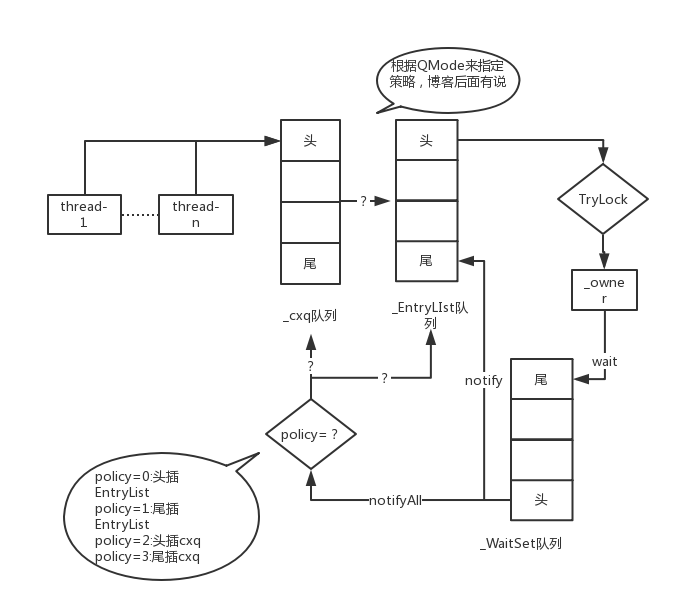最简单的东西,往往包含了最复杂的实现,因为需要为上层的存在提供一个稳定的基础,Object作为java中所有对象的基类,其存在的价值不言而喻,其中wait和notify方法的实现多线程协作提供了保证。
案例
public class WaitTestDemo {
public static void main(String[] args) {
Message msg = new Message("process it");
Waiter waiter = new Waiter(msg);
new Thread(waiter,"waiterThread").start();
Waiter waiter1 = new Waiter(msg);
new Thread(waiter1, "waiter1Thread").start();
Notifier notifier = new Notifier(msg);
new Thread(notifier, "notifierThread").start();
System.out.println("All the threads are started");
}
public static class Message {
private String msg;
public Message(String str){
this.msg=str;
}
public String getMsg() {
return msg;
}
public void setMsg(String str) {
this.msg=str;
}
}
public static class Waiter implements Runnable{
private Message msg;
public Waiter(Message m){
this.msg=m;
}
@Override
public void run() {
String name = Thread.currentThread().getName();
synchronized (msg) {
try{
System.out.println(name+" waiting to get notified at time:"+System.currentTimeMillis());
msg.wait();
}catch(InterruptedException e){
e.printStackTrace();
}
System.out.println(name+" waiter thread got notified at time:"+System.currentTimeMillis());
//process the message now
System.out.println(name+" processed: "+msg.getMsg());
}
}
}
public static class Notifier implements Runnable {
private Message msg;
public Notifier(Message msg) {
this.msg = msg;
}
@Override
public void run() {
String name = Thread.currentThread().getName();
System.out.println(name+" started");
try {
Thread.sleep(1000);
synchronized (msg) {
msg.setMsg(name+" Notifier work done");
msg.notify();
msg.notify();
//msg.notifyAll();
}
} catch (InterruptedException e) {
e.printStackTrace();
}
}
}
}
Output:
All the threads are started
waiterThread waiting to get notified at time:1572344152693
waiter1Thread waiting to get notified at time:1572344152693
notifierThread started
waiterThread waiter thread got notified at time:1572344153705
waiterThread processed: notifierThread Notifier work done
waiter1Thread waiter thread got notified at time:1572344153706
waiter1Thread processed: notifierThread Notifier work done
也可以使用notifyAll,输出为:
All the threads are started
waiterThread waiting to get notified at time:1572344222162
waiter1Thread waiting to get notified at time:1572344222162
notifierThread started
waiter1Thread waiter thread got notified at time:1572344223175
waiter1Thread processed: notifierThread Notifier work done
waiterThread waiter thread got notified at time:1572344223177
waiterThread processed: notifierThread Notifier work done
发现最后唤醒的顺序颠倒了
执行完notify方法,并不会立马唤醒等待线程,在notify方法后面加一段sleep代码就可以看到效果,如果线程执行完notify方法之后sleep 5s,在这段时间内,线程waiterThread1依旧持有monitor,线程waiterThread只能继续等待;
为什么要使用synchronized?
在Java中,synchronized有两种使用形式,同步方法和同步代码块。代码如下:
public class SynchronizedTest {
public synchronized void doSth(){
System.out.println("Hello World");
}
public void doSth1(){
synchronized (SynchronizedTest.class){
System.out.println("Hello World");
}
}
}
我们先来使用Javap来反编译以上代码,结果如下(部分无用信息过滤掉了):
public synchronized void doSth();
descriptor: ()V
flags: ACC_PUBLIC, ACC_SYNCHRONIZED
Code:
stack=2, locals=1, args_size=1
0: getstatic #2 // Field java/lang/System.out:Ljava/io/PrintStream;
3: ldc #3 // String Hello World
5: invokevirtual #4 // Method java/io/PrintStream.println:(Ljava/lang/String;)V
8: return
public void doSth1();
descriptor: ()V
flags: ACC_PUBLIC
Code:
stack=2, locals=3, args_size=1
0: ldc #5 // class com/hollis/SynchronizedTest
2: dup
3: astore_1
4: monitorenter
5: getstatic #2 // Field java/lang/System.out:Ljava/io/PrintStream;
8: ldc #3 // String Hello World
10: invokevirtual #4 // Method java/io/PrintStream.println:(Ljava/lang/String;)V
13: aload_1
14: monitorexit
15: goto 23
18: astore_2
19: aload_1
20: monitorexit
21: aload_2
22: athrow
23: return
反编译后,我们可以看到Java编译器为我们生成的字节码。在对于doSth和doSth1的处理上稍有不同。也就是说。JVM对于同步方法和同步代码块的处理方式不同。
对于同步方法,JVM采用ACC_SYNCHRONIZED标记符来实现同步。 对于同步代码块。JVM采用monitorenter、monitorexit两个指令来实现同步。
关于这部分内容,在JVM规范中也可以找到相关的描述。
同步方法
方法级的同步是隐式的。同步方法的常量池中会有一个ACC_SYNCHRONIZED标志。当某个线程要访问某个方法的时候,会检查是否有ACC_SYNCHRONIZED,如果有设置,则需要先获得监视器锁,然后开始执行方法,方法执行之后再释放监视器锁。这时如果其他线程来请求执行方法,会因为无法获得监视器锁而被阻断住。值得注意的是,如果在方法执行过程中,发生了异常,并且方法内部并没有处理该异常,那么在异常被抛到方法外面之前监视器锁会被自动释放。
同步代码块
同步代码块使用monitorenter和monitorexit两个指令实现。 The Java® Virtual Machine Specification 中有关于这两个指令的介绍:
大致内容如下: 可以把执行monitorenter指令理解为加锁,执行monitorexit理解为释放锁。 每个对象维护着一个记录着被锁次数的计数器。未被锁定的对象的该计数器为0,当一个线程获得锁(执行monitorenter)后,该计数器自增变为 1 ,当同一个线程再次获得该对象的锁的时候,计数器再次自增。当同一个线程释放锁(执行monitorexit指令)的时候,计数器再自减。当计数器为0的时候。锁将被释放,其他线程便可以获得锁。
归总
同步方法通过
ACC_SYNCHRONIZED关键字隐式的对方法进行加锁。当线程要执行的方法被标注上ACC_SYNCHRONIZED时,需要先获得锁才能执行该方法。同步代码块通过
monitorenter和monitorexit执行来进行加锁。当线程执行到monitorenter的时候要先获得所锁,才能执行后面的方法。当线程执行到monitorexit的时候则要释放锁。每个对象自身维护这一个被加锁次数的计数器,当计数器数字为0时表示可以被任意线程获得锁。当计数器不为0时,只有获得锁的线程才能再次获得锁。即可重入锁。
底层原理
对象头和内置锁(ObjectMonitor)
每个对象分为三块区域:_对象头、实例数据和对齐填充_。
- 对象头包含两部分,第一部分是Mark Word,用于存储对象自身的运行时数据,如哈希码(HashCode)、GC分代年龄、锁状态标志、线程持有的锁、偏向线程 ID、偏向时间戳等等,这一部分占一个字节。第二部分是Klass Pointer(类型指针),是对象指向它的类元数据的指针,_虚拟机通过这个指针来确定这个对象是哪个类的实例_,这部分也占一个字节。(如果对象是数组类型的,则需要3个字节来存储对象头,因为还需要一个字节存储数组的长度)
- 实例数据存放的是类属性数据信息,包括父类的属性信息,如果是数组的实例部分还包括数组的长度,_这部分内存按4字节对齐_。
- 填充数据是因为虚拟机要求对象起始地址必须是8字节的整数倍。填充数据不是必须存在的,仅仅是为了字节对齐。
级锁定、重量级锁定、GC标记、可偏向)下对象的存储内容如下表所示。 
Synchronized通常被称为重量级锁,但是1.6之后对其进行优化,_新增了轻量级锁和偏向锁_,这里重点说下重量级锁,随后对Synchronized的优化简单介绍下。
从对象头的存储内容可以看出锁的状态都保存在对象头中,Synchronized也不例外,当其从轻量级锁膨胀为重量级锁时,锁标识位为10,其中_指针指向的是monitor对象_(也称为管程或监视器锁)的起始地址。
关于Synchronized的实现在java对象头里较为简单,只是改变一下标识位,并将指针指向monitor对象的起始地址,其实现的重点是monitor对象。
在HotSpot虚拟机中,monitor采用ObjectMonitor实现。
内置锁(ObjectMonitor)
通常所说的对象的内置锁,是对象头Mark Word中的重量级锁指针指向的monitor对象,该对象是在HotSpot底层C++语言编写的(openjdk里面看),简单看一下代码:
//结构体如下
ObjectMonitor::ObjectMonitor() {
_header = NULL;
_count = 0;
_waiters = 0,
_recursions = 0; //线程的重入次数
_object = NULL;
_owner = NULL; //标识拥有该monitor的线程
_WaitSet = NULL; //等待线程组成的双向循环链表,_WaitSet是第一个节点
_WaitSetLock = 0 ;
_Responsible = NULL ;
_succ = NULL ;
_cxq = NULL ; //多线程竞争锁进入时的单向链表
FreeNext = NULL ;
_EntryList = NULL ; //_owner从该双向循环链表中唤醒线程结点,_EntryList是第一个节点
_SpinFreq = 0 ;
_SpinClock = 0 ;
OwnerIsThread = 0 ;
}
ObjectMonitor队列之间的关系转换可以用下图表示: 
既然提到了_waitSet和_EntryList(_cxq队列后面会说),那就看一下底层的wait和notify方法
wait方法的实现过程:
//1.调用ObjectSynchronizer::wait方法
void ObjectSynchronizer::wait(Handle obj, jlong millis, TRAPS) {
/*省略 */
//2.获得Object的monitor对象(即内置锁)
ObjectMonitor* monitor = ObjectSynchronizer::inflate(THREAD, obj());
DTRACE_MONITOR_WAIT_PROBE(monitor, obj(), THREAD, millis);
//3.调用monitor的wait方法
monitor->wait(millis, true, THREAD);
/*省略*/
}
//4.在wait方法中调用addWaiter方法
inline void ObjectMonitor::AddWaiter(ObjectWaiter* node) {
/*省略*/
if (_WaitSet == NULL) {
//_WaitSet为null,就初始化_waitSet
_WaitSet = node;
node->_prev = node;
node->_next = node;
} else {
//否则就尾插
ObjectWaiter* head = _WaitSet ;
ObjectWaiter* tail = head->_prev;
assert(tail->_next == head, "invariant check");
tail->_next = node;
head->_prev = node;
node->_next = head;
node->_prev = tail;
}
}
//5.然后在ObjectMonitor::exit释放锁,接着 thread_ParkEvent->park 也就是wait
总结:通过object获得内置锁(objectMonitor),通过内置锁将Thread封装成OjectWaiter对象,然后addWaiter将它插入以_waitSet为首结点的等待线程链表中去,最后释放锁。
notify方法的底层实现
//1.调用ObjectSynchronizer::notify方法
void ObjectSynchronizer::notify(Handle obj, TRAPS) {
/*省略*/
//2.调用ObjectSynchronizer::inflate方法
ObjectSynchronizer::inflate(THREAD, obj())->notify(THREAD);
}
//3.通过inflate方法得到ObjectMonitor对象
ObjectMonitor * ATTR ObjectSynchronizer::inflate (Thread * Self, oop object) {
/*省略*/
if (mark->has_monitor()) {
ObjectMonitor * inf = mark->monitor() ;
assert (inf->header()->is_neutral(), "invariant");
assert (inf->object() == object, "invariant") ;
assert (ObjectSynchronizer::verify_objmon_isinpool(inf), "monitor is inva;lid");
return inf
}
/*省略*/
}
//4.调用ObjectMonitor的notify方法
void ObjectMonitor::notify(TRAPS) {
/*省略*/
//5.调用DequeueWaiter方法移出_waiterSet第一个结点
ObjectWaiter * iterator = DequeueWaiter() ;
//6.后面省略是将上面DequeueWaiter尾插入_EntrySet的操作
/**省略*/
}
总结:通过object获得内置锁(objectMonitor),调用内置锁的notify方法,通过_waitset结点移出等待链表中的首结点,将它置于_EntrySet中去,等待获取锁。注意:notifyAll根据policy不同可能移入_EntryList或者_cxq队列中,此处不详谈。




